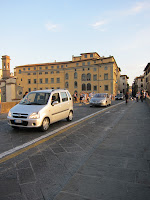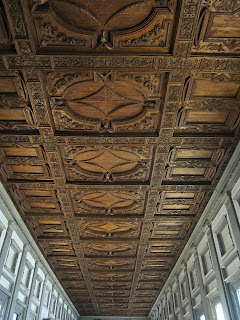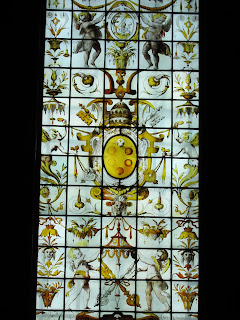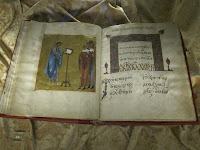6/28
This morning we finally visited the Accademia- a.k.a. the home of Michelangelo's
David! Our Uffizzi Card got us in for free and without a line (woohoo!) and after my cup of cappuccino, pastry with marmalade, and security screening, I was ready to study fantastic art in the Galleria dell'Accademia!
This museum is special for several reasons. In the context of Renaissance study, the Accademia is one of Florence's greatest claims to fame: the first Academy of Art in ALL of Europe. Finally a secular institution created for the sole purpose of educating artists! This was such an innovative idea that it spread from Florence to other major cities and capitals in Europe!
The Galleria of today, was collected and opened much later than the Renaissance, but the collection displayed focuses on providing Renaissance and Medieval masterworks to tourists and the students of Florence's Academy of Art (for study and sketching). I honestly don't know how the students stand all the milling tourists, but the ones we've seen this summer seem to go on about their studies without complaint!
The Accademia's crowning jewel and biggest draw is Michelangelo's
David. The massive statue was originally created as a fixture for the exterior of the Duomo (hence its giant size and strange proportions) but it was decided by the people of Florence that this symbol of freedom should instead be placed in the Piazza della Signoria, outside of the Palazzo Vecchio and the Uffizzi.
The replica does justice to the original
David but it is awe inspiring to see the original and be able to approach it for close observation.
David stands on a round pedestal so that he is elevated and visitors can walk around him for a 360 degree accessible view. Up close, you can see the veins in
David's arms and legs! It is one of Michelangelo's colossal and brilliant works. I, along with all of the other tourists, caught my breath.
The Accademia also houses several other Michelangelo pieces along with other Renaissance and Medieval treasures. But beyond these and even the
David, I particularly enjoyed a special exhibit in a set of rooms adjoined to the central hall
. Behind a silver colored curtain and around the corner from the main entrance (both entrances hard to find!) was a series of rooms displaying the work of another, much later, Italian sculptor: Lorenzo Bartolini (1777-1850).
I absolutely fell in love with his work!
Not an artist of the Renaissance, but heavily influenced by Renaissance art, Bartolini's work was on display and advertised all over Florence. I totally and completely fell in love with his work. The realism and delicacy of his marble statues is incredible. One, called
"Trust in God" looked as if she were breathing. Everything, from the details of her face to her posture, the position of kneeling with one foot over the top of the other with small creases on the instep, seem so real and are so expressive! Another statue called
Venus (inspired by Titian's
Venus of Urbino) was a reclining nude with wavy hair and an elbow resting on a leather pillow. The creases in the pillow from the weight of her body is a detail that impressed me enough to walk back several times for another look. A third was a depiction of Charity holding young children to her. The naturalism and delicacy of the figures is stunning!
Bartolini statues are much warmer and more alive than any other marble statues I've seen. They are not as dynamic as Rodin's work, but simply, elegantly, and classically beautiful. I cannot say enough about this neoclassical artist and I am very sad that photography was entirely forbidden in the Accademia.
Here is a borrowed image from another online blog:
Fiducia in Dio (Trust in God)- 1835
After seeing Bartolini's work collected in one place, reading through all of the descriptions about his influences, seeing a room of his plaster casts and watching a video about his artistic process (along with the marble statues there was also a room filled with plaster molds for his bronze works), the artist has become my favorite sculptor - well my favorite neoclassical sculptor. ;)
After finishing with the Accademia we walked to San Lorenzo to see the Cappella dei Principi, the tombs in the Medici Chapel and the Laurentian Library.
The day was one of the hottest so far, so being close to noon many of us were nearing exhaustion, but it was quite wonderful to be able to see the impressive Cappella dei Principi where the Medici grand dukes are buried as well as Michelangelo's designs for the Medici tombs and for the Biblioteca Mediceo-Laurenziana.
Medici crest marks the spot!
Across from San Lorenzo and the Capelle entrance was a building with remnants of a beautifully decorated exterior!
Edge of the San Lorenzo market on the street where we were waiting
We went first to the Cappella dei Prinicipi, which holds the tombs of six grand dukes. This chapel is, first of all, massive. Again, photography was banned so most of the impressions I had were a mere capturing of the eye. It is an immense, cold- compared to the heat of the day outside- elaborately decorated space.
One of the photos I was able to sneak. The strange angle is due to me hiding behind one of the construction areas (renovation is currently underway) to snap a few photos without catching the eye of the guards! Living dangerously in Florence! ;P
According to the guidebook, the dome created for this ceiling was inspired (or rather copied) after Brunelleschi's Duomo. To a visitor it is clearly an expression of great wealth meant to honor and to awe.
.....
We have more power, money and glory than you do...in your face...Medicis Rule!!! ... :D
And rule they did, for at the time the Medici were still powerful as a family not just as Florentine grand dukes but as heads of the Catholic Church. They could afford to hire the best of the best to design and execute a room of tombs fit for the highest of kings. Moving into the space designed by Michelangelo for Lorenzo the Magnificent and his brother Giuliano is a visceral and dramatic experience. There is something of awe in the space. Facing one another from opposite ends of the room are the two tombs with beautifully rendered marble sculptures entitled
Day and Night and
Dawn and Dusk by Michelangelo
.
Here are just a few of the photos I snapped on the sly:
Tomb of the Baton Carrier (Lorenzo de' Medici) with Night and Day
Tomb of the Thinker (Giuliano de' Medici) whose face you can't see! with Dawn and Dusk
Sneak peek of the inlay decoration within the new sacristy
Michelangelo's Virgin and Child (center), South wall of the new sacristy
After visiting the tombs we went around the church to the cloister (one of my favorite places in Florence), and waited for our tickets. Then we walked up to the Laurentian Library!
Cloister of San Lorenzo with the Duomo and its bell tower in the background
The Laurentian Library addition to the church of San Lorenzo was also a Michelangelo creation. The reason for it being built? The library was originally created to give scholars access to the many scrolls and books that the Medicis collected.
A place for Humanists to come, read, talk, and possibly debate. As usual...me + library = happiness! :)
Our first stop was the atrium to the library.
Designed by Michelangelo, this space is elegant and vast. As you can see from the picture of our group listening to the lecture we humans look quite small in comparison to the space itself.
Architecturally it reminds a bit of Brunelleschi; the decoration is minimal and the lines and proportions are symmetrical and sparse.
Beautiful and giant scroll decoration
Decorative features of the wall and stairs leading up to the reading room. Up the stairs! Finally the famous library!
The room is one long hall with rows upon rows of antique desks on either side. In the middle of the image you can see a long strip of the elaborate inlaid marble floor which spans the length of the library. Sadly, but also thankfully, it is covered up on both sides to allow visiting tourists to see it up close! So cool to be able to look in detail and photograph it all!
Detail of the floor
Detail of the floor
The ceiling

Detail
The desks are designed specifically for reading, the perfect size for unrolling a scroll or looking at an illuminated manuscript!
The "Seats"- desks or benches
On the side of each desk is a listing of the books it would have contained. According to the website of the museums of Florence, rare books were a commodity in the Renaissance too and theft was a potential issue! During the time that the library functioned, books within each desk were chained to it permanently, under strict supervision and locked.
How amazing, right? I kept picturing these wizened Renaissance scholars in their robes and hats coming here to study within the benevolent sphere of the Medici. Our guide told us that this library (collection of scrolls and manuscripts), which still exists in Italy, was one of the greatest gifts that the Medici family has left to Florence.
And speaking of gifts, the Medici also left their calling cards:
Plaque commemorating the library of the great Cosimo Medici. Cosimo Vecchio (Lorenzo the Magnificent's and Giuliano's grandfather) was the first to start the collection that his progeny would add to. The Medici popes made sure that the library was built and Cosimo Primo saw it completed.
Stained glass windows that line the sides of the library. This one has the Medici crest with a crown above it, the Florentine fleur-de-lys featured on the top-most coin, keys (perhaps to the city):
The overall message... we are the best and we rule (figuratively and literally)!
Tribuna d'Elci
Other families also left books to Florence. On the way out of the library you can see the Tribuna d'Elci a later addition that houses stamps and books donated by Angelo Maria d’Elci.
Altogether, the library is gorgeous and quite impressive. It makes me curious about all the great Humanist minds that came here during the Renaissance and after. It's fun to imagine what this space was like when the Medicis ruled and deep readers and thinkers came here to study. Can you imagine the conversations that were sparked? If only I had access to a time machine so that I could be a 16th century fly on this wall!
And that was not all of the awesomeness that our tickets to the library bought! Outside the library's ooh-la-la atrium, there was an exhibit of Byzantine manuscript illuminations from the library's collection! The exhibit
Voices from the East, showcased Byzantine books on diverse subjects like theology, philosophy, the sciences, literature etc. that had to do particularly with Ancient Greece and early Christian Bibles and/or Gospel books, written or produced in Byzantium by its many scholars. Before it was invaded and conquered by the Islamic armies of the East, Byzantium was a flourishing empire particularly in its scholarship and technology. The flight of scholars from Constantinople to the shores of Italy after their city was sacked, brought materials and Eastern scholarship on classics and Christianity to Italy. It is no wonder that the Medicis were interested in obtaining these rare treasures for themselves!
Unlabeled Bibles, Gospel Books, and others. Sorry!:
I'm so sad to say that the heat made me a bit lazy. All the books above I didn't get a label for. But...
Bible, Gospels. MS open to page of Luke and the incipit of his Gospel. Constantinople. Second half of the 11th century.
Here you can see how the book closes.
Bible, Gospels. Manuscript open to page with the evangelist John and the incipit of his gospel. Constantinople. Second half of the 11th century.
Bible, Gospels. Manuscript is open to Matthew 8 the leper. Constantinople end of the 11th or beginning of the 12th century.
Detail.
Bible, Gospels. Open to page with table of contents and chapters of Matthew. Constantinople. First half of the 11th century.
Detail.
Manuscript illustration. Simia of Rhodes, The Wings.
Details.
Medical Miscellany
Medical Miscellany. Manuscript is open to the page illustrating a method of reducing dislocated vertabrae, from the treatise by Appolonius of Citium. Constantinople. First third of the 10th century.
Theon. Commentary on Ptolemy's Handy Tables. The manuscript is open to a page with a table of the motions of the five planets. Constantinople, 886-912 CE.
Theon and Pappus. Commentaries on Ptolemy's Almagest. Constantinople. 9th Century. Page is open to a diagram for an instrument used to measure the parallax.
Aristotle. Moral Writings. Constantinople. Second half of the 9th century.
Page is open to the incipit of Book One of the Nicomachean Ethics.
Proclus. Commentaries on Plato's Republic. Constantinople. Third quarter of the 9th Century. Page is open to introduction to the Republic.



















































































